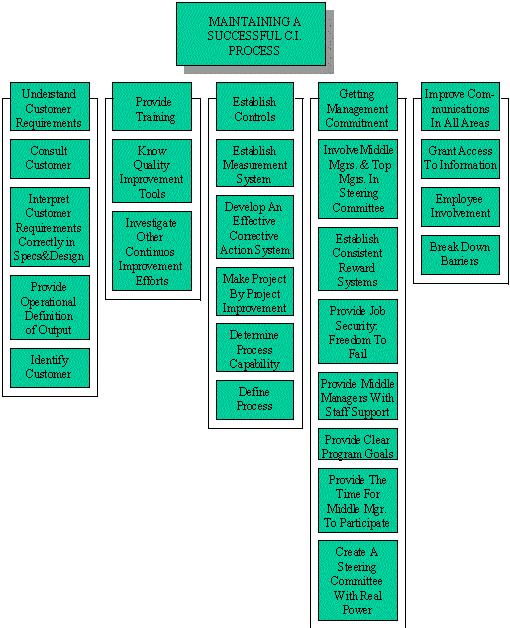Table of contents
Flow Charts
Ishikawa Diagrams
Table of contents |
Affinity Diagrams | HOME |
back to
Flow Charts |
go on to
Ishikawa Diagrams |
Definition: A group decision-making technique designed to sort a large number of ideas, process variables, concepts, and opinions into naturally related groups. These groups are connected by a simple concept. Purpose: To sort a list of ideas into groups.
Guidelines:
How to Conduct an Affinity Sort:
- Insure ideas are described with phrases or sentences.
- Minimize the discussion while sorting -- discuss while developing the header cards.
- Aim for 5-10 groups.
- If one group is much larger than others, consider splitting it.
Tips:
- Conduct a brainstorming session on the topic under investigation.
- Clarify the list of ideas. Record them on small cards or Post-It notes.
- Randomly lay out cards on a table, flipchart, wall, etc.
- Without speaking, sort the cards into "similar" groups based on your gut reaction. If you don't like the placement of a particular card, move it. Continue until consensus is reached.
- Create header cards consisting of a concise 3-5 word description; the unifying concept for the group. Place header card at top of each group.
- Discuss the groupings and try to understand how the groups relate to each other.
- Inquire whether ideas are adequately clarified.
- Use only 3-5 words in the phrase on the header card to describe the group.
- If possible, have groupings reviewed by non-team personnel.
- While sorting, physically get up and gather around the area where the cards are placed.
- Team members will ultimately reach agreement on placement, if for no other reason than exhaustion.
- Sorting should not start until all team members are ready.
- If an idea fits in more than one category or group, and consensus about placement cannot be reached, make a second card and place it in both groups.
|
|
 |
|
Copyright, Goal/ QPC, Methuen, MA. Used
with permission.
|
Table of contents |
Affinity Diagrams | HOME |
back to
Flow Charts |
go on to
Ishikawa Diagrams |